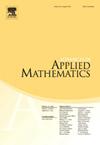Proof of a K-theoretic polynomial conjecture of Monical, Pechenik, and Searles
IF 1.3
3区 数学
Q3 MATHEMATICS, APPLIED
引用次数: 0
Abstract
As part of a program to develop K-theoretic analogues of combinatorially important polynomials, Monical, Pechenik, and Searles (2021) proved two expansion formulas and , where each of , , and is a family of polynomials that forms a basis for indexed by weak compositions a, and and are monomials in β for each pair of weak compositions. The polynomials are the Lascoux atoms, are the kaons, are the quasiLascoux polynomials, and are the glide polynomials; these are respectively the K-analogues of the Demazure atoms , the fundamental particles , the quasikey polynomials , and the fundamental slide polynomials . Monical, Pechenik, and Searles conjectubolded that for any fixed a, , where b ranges over all weak compositions. We prove this conjecture using a sign-reversing involution.
Monical, Pechenik和Searles的一个k理论多项式猜想的证明
作为开发组合重要多项式的k理论类似物的计划的一部分,Monical, Pechenik和Searles(2021)证明了两个展开公式a - a=∑bQba(β)P - b和Q - a=∑bQba(β) F - b,其中a - a, P - a, Q - a和F - a中的每一个都是一个多项式族,它形成了由弱组合a索引的Z[x1,…,xn][β]的基础,Qba(β)和Mba(β)是β中的单项式对于每一对(a,b)弱组合。其中A - A是拉斯考克斯原子,P - A是介子,Q - A是准拉斯考克斯多项式,F - A是滑翔多项式;它们分别是Demazure原子Aa、基本粒子Pa、准多项式Qa和基本滑动多项式Fa的k -类似物。Monical, Pechenik和Searles推测,对于任意固定的a,∑bQba(- 1),∑bMba(- 1)∈{0,1},其中b在所有弱组合上都有范围。我们用一个逆号对合证明了这个猜想。
本文章由计算机程序翻译,如有差异,请以英文原文为准。
求助全文
约1分钟内获得全文
求助全文
来源期刊

Advances in Applied Mathematics
数学-应用数学
CiteScore
2.00
自引率
9.10%
发文量
88
审稿时长
85 days
期刊介绍:
Interdisciplinary in its coverage, Advances in Applied Mathematics is dedicated to the publication of original and survey articles on rigorous methods and results in applied mathematics. The journal features articles on discrete mathematics, discrete probability theory, theoretical statistics, mathematical biology and bioinformatics, applied commutative algebra and algebraic geometry, convexity theory, experimental mathematics, theoretical computer science, and other areas.
Emphasizing papers that represent a substantial mathematical advance in their field, the journal is an excellent source of current information for mathematicians, computer scientists, applied mathematicians, physicists, statisticians, and biologists. Over the past ten years, Advances in Applied Mathematics has published research papers written by many of the foremost mathematicians of our time.
 求助内容:
求助内容: 应助结果提醒方式:
应助结果提醒方式:


